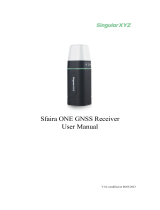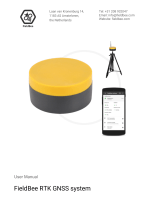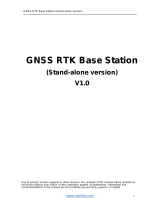5
Phoenix LiDAR Systems is not responsible for nor warrants the viability of the space segment portion of the GNSS system.
The user is cautioned that they alone are responsible for determining the suitability of the S900 receivers to
their task at hand. Any of the GNSS system components can fail at any time (especially with real-time networks), so be
prepared for down time and failures.
Use and Care
The S900 GNSS receivers are field ready instruments; however they are also delicate electronic instruments. Take suitable
care to avoid damage to the instrument.
● Avoid dropping the receiver as it can change the phase center of the antenna!
● Avoid storing the receiver at excessive temperatures (hot or cold) as it will damage the internal batteries.
● Avoid storing the batteries at temperatures less than -40° F (-40° C) and temperatures higher than 160°F
(70°C) as it will permanently reduce the battery capacity and life.
● DO NOT leave the receivers or accessories inside a vehicle in the summer. Temperatures higher than 160°F
will permanently reduce battery capacity and battery life.
Battery Warnings
The batteries supplied with your receiver are Lithium-Ion type cells.
WARNING - Do not damage the rechargeable Lithium-ion battery. A damaged battery can cause an explosion or fire, and can
result in personal injury and property damage.
To prevent injury or damage:
● Do not use or charge the battery if it appears to be discolored, warped, or leaking battery fluid.
● Do not expose the battery to fire, high temperature, or direct sunlight.
● Do not immerse the battery in water.
● Do not store the battery inside a vehicle during hot weather.
● Do not drop or puncture the battery.
● Do not open the battery or short-circuit its contacts.
● Do not charge the batteries in chargers other than the supplied charger or a direct replacement.
● Do not charge similar batteries in the supplied charger, even if they fit well.
● WARNING - Avoid contact with the rechargeable Lithium-ion battery if it appears to be leaking. The battery
fluid is extremely corrosive, and contact with it will result in personal injury and/or property damage.
● If battery fluid gets into your eyes, immediately rinse your eyes with clean water and seek medical attention.
Do not rub your eyes!
● If battery fluid gets onto your skin or clothing, immediately use clean water to wash off the battery fluid.
Each battery, when new, will power the receiver for approximately 5 hours at temperatures higher than 50 degrees F. At lower
temperatures battery life is shortened. The S900 receivers are equipped with two battery compartments. Two new fully
charged batteries will power the unit for 10 hours.
Fully charge the batteries using the supplied charger before first use
TOO COLD: Do not leave charged or uncharged batteries in your vehicle at night if the temperature will be less than 20 deg F.
Extreme cold battery storage will permanently reduce the capacity and lifetime of the batteries.

























